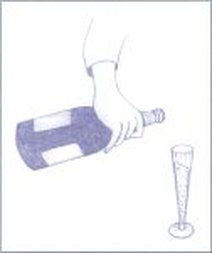HOW TO HOLD AND POUR A BOTTLE OF WINE
Hold a bottle of table wine in the palm of the hand, label facing the guest, so he or she may see the vintage year. To insulate chill, wrap a napkin around the neck. To avoid spills, bring the bottle to the glass and twist the bottle over the glass to halt the drops.
Pour table wine down the inside of a glass. Wine with a greater alcohol content is less free flowing or more viscous than wine with a low alcohol content, a condition apparent by shapes called tears or legs that appear on the inside wall of the glass. Arches, or "cathedral windows," are a visible sign of the reduced viscosity of heavier wine made by a high level of alcohol or residual sugar.
To maintain effervescence, pour champagne soon after the bottle is opened, and in almost a trickle so as not to overly stimulate the bubbles. Pour a small amount of champagne into a glass, let the froth settle for a moment, then fill the glass approximately three-quarters full.
Pour table wine down the inside of a glass. Wine with a greater alcohol content is less free flowing or more viscous than wine with a low alcohol content, a condition apparent by shapes called tears or legs that appear on the inside wall of the glass. Arches, or "cathedral windows," are a visible sign of the reduced viscosity of heavier wine made by a high level of alcohol or residual sugar.
To maintain effervescence, pour champagne soon after the bottle is opened, and in almost a trickle so as not to overly stimulate the bubbles. Pour a small amount of champagne into a glass, let the froth settle for a moment, then fill the glass approximately three-quarters full.



